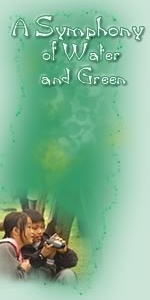 |
Kaohsiung is a prevailing city in terms of its geographical location and
transportation. Besides having both international seaport and airport, a rich and diverse cultural landscape, Kaohsiung also possesses the uniquely combined characteristics and resources of rivers, ocean, harbor and mountains. In recent years, in order to enhance the efficiency of the tourism industry, Kaohsiung City Government has made great efforts to achieve optimal use of the natural sceneries of the mountains, ocean and rivers, as well as the landscapes of its ports, coastal lines, and waterfronts. Kaohsiung City Government is building the city focusing on health consciousness and Kaohsiung's role as "Taiwan's Maritime Capital". In terms of riverbank panorama restoration among other various constructions, under the long-term efforts of the City Government, there has been apparent advancement in both the water quality and coastal scenery reformation of the three main rivers passing through Kaohsiung.
1. Love River
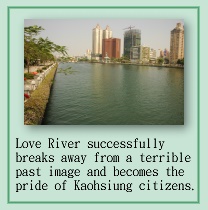
The Kaohsiung Harbor construction project was launched in 1908 during the period of Japanese colonization of Taiwan, which caused severe impacts on the eco-system of the Love River, in particular, the mangrove forest along the river. Fish began to disappear, and the Love River saw its darkest period in the 1970s as industries developed rapidly in Kaohsiung. The Kaohsiung City Government launched the Love River restoration project in 1979.
 Thanks to rigorous efforts over the past two decades, plus the benefits of rapidly-constructed sewers and domestic sewage emission control in recent years, Love River maintained its water quality above a third-rate level in many years of examination. The ecology of Love River gradually recovered and aquatic life started to re-emerge. This shows that Love River has finally broken away from its image of a terrible past and has become the pride of Kaohsiung citizens.
Besides the re-emergence of aquatic life in the river, specially designed water steps are built alongside the banks. Wood-lined trails and picnic gazebos have also been built along the restored Love River. Residents may spend a leisurely afternoon, strolling down the green belt lined with golden shower, willow and flame trees.
It is indeed incredible scenery that is unforgettable.
The Kaohsiung Museum of History, Kaohsiung Municipal Film Archive and the Taiwan Medical History Digital Museum form a cultural pyramid close to the Love River. You can take an informative tour of the museums and learn about local cultures and history. The Lanterns' Festival held annually along the riverside has helped to make the Love River the glittering gem of the city. Savor a cup of coffee, listen to some music and enjoy a relaxing and romantic afternoon in one of the riverside caf?s, "Golden Love River" and "Riverside Mambo".
2. Cianjhen River
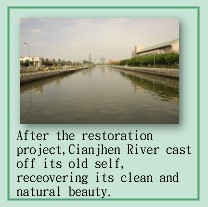 Cianjhen River is the downstream of Fengshan Stream. Its source of water also comes from Caogong Canal. Cianjhen River, black and smelly in the past, was once nicknamed by its nearby inhabitants as "Heilongjiang", which means extremely dirty and blackish because of severe pollution. Most houses were built with their backs towards the river. However, after four years of the Cianjhen River restorationproject, and the on-going sewage-water division plan, Cianjhen River is the downstream of Fengshan Stream. Its source of water also comes from Caogong Canal. Cianjhen River, black and smelly in the past, was once nicknamed by its nearby inhabitants as "Heilongjiang", which means extremely dirty and blackish because of severe pollution. Most houses were built with their backs towards the river. However, after four years of the Cianjhen River restorationproject, and the on-going sewage-water division plan, 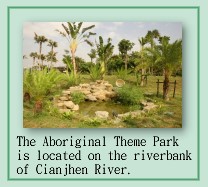 the City Government has cast off the old Cianjhen River and recovered the clean, natural beauty of Cianjhen River, which now nurtured a great variety of river life. the City Government has cast off the old Cianjhen River and recovered the clean, natural beauty of Cianjhen River, which now nurtured a great variety of river life.
The water accessible park, the green-land constructions as well as many sight spots along the riverside, such as the Zhu Ancestral Shrine, the Aboriginal Service Center and Jen Nan Temple, enriches the spiritual lives of the inhabitants living nearby. Besides, the performance square, rest plaza, stone paths, riverside scenic paths and water steps of Cianjhen River are all excellent places for people to enjoy their leisure activities. At night, Cianjhen River, with nearby lights reflected on the surface of the water, is an enchanting place!
3. Houjin Creek
Houjin Creek is comprised of two branches. One is Caogong Canal that originates from Niaosong Township in Kaohsiung County; the other is Nanzih Creek that originates from Dashe Township. This river basin is 21 kilometers in length and covers an area of 70.4 square kilometers. It flows through the Nanzih District, Renwu and Dashe Townships of Kaohsiung County.
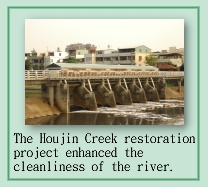 In the past, the clean waters of Houjin Creek was polluted by the sewage of industries and oil refineries along the water banks. In recent years, the City Government has launched the Houjin Creek restoration project, which is mainly the implementation of a sewage distribution system that restores the nature of the river. Together with the nearby greenlands and bike paths, Houjin Creek has become a recreation center for strolling, exercise, outings and interactions. Just as the Love River, the Houjin Creek is greatly anticipated to become another "River of the City".
Presently, the restoration project of Houjin Creek has broadened the narrow river surface located at the intersection of Kaohsiung City and Kaohsiung County. Its width is changed from the original 30 meters to 80 meters. In the future, the City Government will hasten the constructions of Nanzih District sewer system, the river sewage disposal system and water quality improvement projects, so as to provide the northern Kaohsiung areas with a better water-friendly environment. Presently, the banks of Houjin Creek have been developed into greenlands, of which the first two eye-catching sight spots are Qingfugou Riverside Park and the 90-hectare city park, which is located midstream. In addition, the downstream area of Houjin Creek has a beautiful, wide-open scenic view where Kaohsiung's Banping Mountain can be seen from afar. It is hoped that in the near future, we can recover a Houjin Creek full of vitality.
Reflection
Kaohsiung is a city of water, suffused by the three main water systems of Lover River, Cianjhen River and Houjin Creek. Very often, elders tell stories from their past, when the rivers were clear and refreshing. As small children, they often had fun catching fish and shrimps in the river. The rivers were also a good place to enjoy fresh breeze or to take in some fresh air. Although a vision like that is distant from where we stand now, we have already noticed the changes of Kaohsiung. The most apparent and successful example is the extreme changes of Love River, which is a recognition to all the hard efforts made by the City Government. It is our strong belief that the City Government's efforts in restoring the three main water systems will construct the veritable city of "New Fragrant Riverbanks"-Kaohsiung.
|

